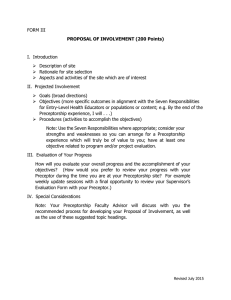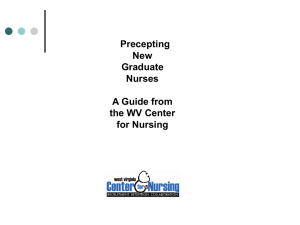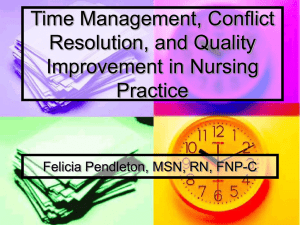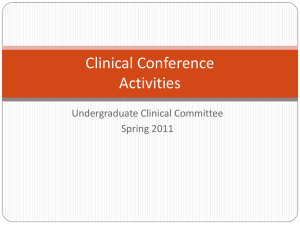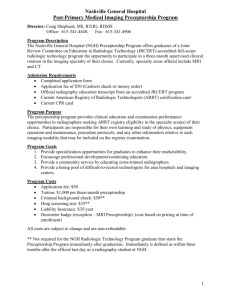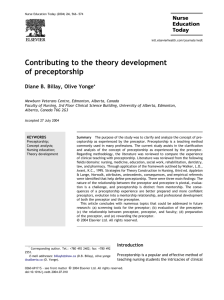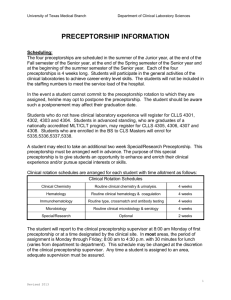Evaluation of a Preceptorship Program for New Graduates
advertisement
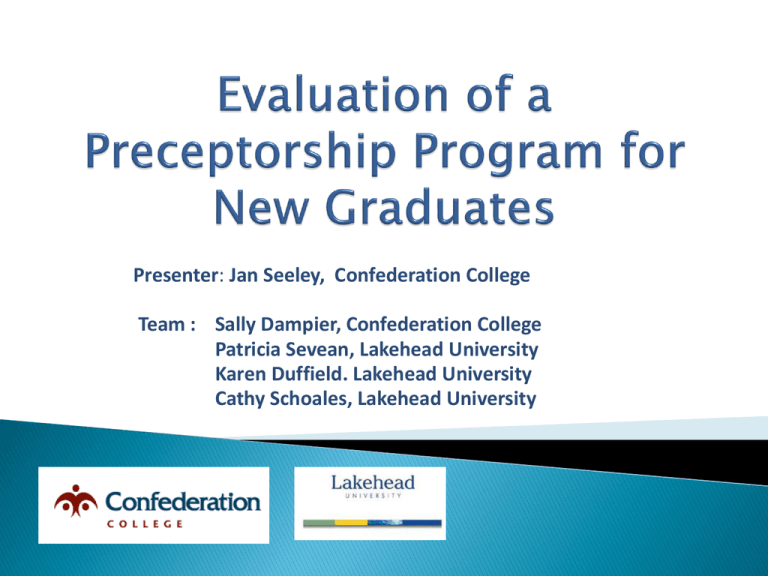
Presenter: Jan Seeley, Confederation College Team : Sally Dampier, Confederation College Patricia Sevean, Lakehead University Karen Duffield. Lakehead University Cathy Schoales, Lakehead University Purpose Background Literature Method Development of Survey Survey Instrument Preliminary Findings Next Steps Conclusion To gather information that would assist in developing a Preceptorship Program for new graduates. The Preceptorship Program was part of the nursing recruitment and retention plan to develop a cadre of experienced preceptors in all clinical areas for the Thunder Bay Regional Health Science Centre. CNA (2004). Achieving Excellence in Professional Practice – A Guide to Preceptorship and Mentoring.’ http://www.cnanurses.ca/CNA/documents/pdf/publications/Achieving_Excellence_2004_ e.pdf RNAO. Preceptorship Resource Kit. http://www.rnao.org/prk/ Public Health Nursing Management (2007). Ontario Nursing Strategy: Preceptorship/Mentorship Initiative Evaluating a Public Health Nursing Mentorship Initiative. http://www.phred-redsp.on.ca/Docs/Reports/OntarioNursingStrategy.pdf Environmental Scan – 2 focus groups (n=10) The sample population (n= 150) was selected from the preceptors involved in the Preceptorship Program at a regional hospital. Participants contacted through an e-mail link which included a letter of information, informed consent and survey. Meetings: Clinical agencies in Northwestern Ontario and Preceptors Reviewed: CNA’s Guide to Preceptorship and Mentorship, RNAO ‘s Preceptorship Resource Kit and Clinical agencies’ Preceptor Orientation Program Conducted: Literature Review Searched: Preceptor Orientation Programs outside of catchment area and Existing survey tools Received: Ethic’s approval Developed: Survey in collaboration with the professional practice group Demographics Gender Professional Qualifications Highest Education Years as a Practicing Nurse Practice Area Current area of practice Status – full-time, part-time, casual Number of years in current area Current position Have you been asked to be a preceptor for a nursing student? If yes – Who asked you to be a preceptor? (manager, nursing student, faculty, another staff, self volunteered, other) What are the benefits (if any) in being a preceptor? What are the challenges (if any) in being a preceptor? If you have NOT being a preceptor, please explain. Very Important Important Undecided Somewhat Important Not Important N/A Clinical Expertise Interest in Teaching Positive Professional Image Effective Role Model Strong Interpersonal Skills Ability to Determine Goals and Priorities Desire to Share Knowledge and Skills Demonstrate Understanding of Organizational Policies/Legislation Very Important Important Undecided Somewhat Important Not Important N/A Adult Learning Principles Learning Styles Fostering Critical Thinking Expectations of the Preceptor Expectations of the Student Expectations of the Faculty Student Evaluation Process Managing Conflict/Problems Managing Diversity (culture, gender, and intergenerational) Have you completed a preceptorship course? Yes/No Did you find the preceptorship course helpful? Yes/No Explain your response (open text box) If you have not completed a preceptorship course, why? Not available Lack of time Lack of money Lack of interest Other (please specify) What would you like to receive PRIOR to the arrival of the nursing student? Check all that apply. Preceptorship Workshop Preceptor resources through the mail Preceptor resources through the internet Student’s learning plan/objectives Contact with faculty Other (please specify) Preceptorship Program – tool kit Clinical coaching - relationship for building and sharing of evidence-based knowledge and skills and attitude (Ervin, 2005; Kopp, Hinkle, 2006, Kowalski, Casper , 2007) Outcome: creating positive workplace environment. Professional Socialization Preceptor and Faculty – on-going communication and support (Hayes, Scott, 2007) Preceptor and Student – compatibility, positive and or optimism learning retention and recruitment summer internship program ‘ripple-effect’(Barker, 2006; Butler, 2006; Kanaskie, 2006; Thomka, 2007; Wilkes, 2006). Outcome: individual and collective power. Preceptorship availability Time, Work load ( van Eps, Cooke, Creedy, Walker, 2006) Numbers - perceived as not being as beneficial as for the student (CASN, 2007) Outcome: pay for service, change in relationship Implication for reflection and change: Development of Preceptor/Mentor Program Clinical Placement – collaborative relationship Partnerships between clinical sites and educators – Best-Practice Guidelines Implication for reflection and change: Environmental scan to identify new clinical placements Maximizing on existing clinical placements - learning opportunities, community nursing Developing curriculum inclusive of: provincial and national standards/competencies Preceptorship is a dynamic and complex relationship that can support growth, increase synergy, and develop ways to succeed as a nurse in an ever changing health care environment. (Barker, 2006) Barker, E. R. (2006). Mentoring--a complex relationship. Journal of the American Academy of Nurse Practitioners, 18(2) 56-61. Butler, M. R., & Felts, J. (2006). Tool kit for the staff mentor: Strategies for improving retention. Journal of Continuing Education in Nursing, 37(5) 210-213. DeCicco, J. (2008). Developing a preceptorship/mentorship model for home health care nurses. Journal of Community Health Nursing, 25(1) 15-25. Ervin, N. E. (2005). Clinical coaching: A strategy for enhancing evidence-based nursing practice. Clinical Nurse Specialist CNS, 19(6) 296-301. Hayes, J. H., & Scott, A. S. (2007). Mentoring partnerships as the wave of the future for new graduates. Nursing Education Perspectives, 28(1) 27-29. Kanaskie, M. L. (2006). Mentoring--a staff retention tool. Critical Care Nursing Quarterly, 29(3) 248-252. . Modic, M. B., & Harris, R. (2007). Masterful preceptoring Using the become method to enhance clinical teaching. Journal for Nurses in Staff Development : JNSD : Official Journal of the National Nursing Staff Development Organization, 23(1) 1-9; quiz 10-1. Smith, P., Spadoni, M., Seeley, J., Sevean, P., Dampier, S., Strickland, D.S. (2007). Project 1: Inventory of Strategies to Deliver Nursing and Interprofessional Clinical Placements in Canada. http://www.casn.ca/en/73.html Smith, P., Seeley, J., Sevean. P. Strickland, D.S., Spadoni, M., Dampier, S. (2007). Project 2: Costing Nursing Clinical Placements in Canada. http://www.casn.ca/en/73.html Vallant, S., & Neville, S. (2006). The relationship between student nurse and nurse clinician: Impact on student learning. Nursing Praxis in New Zealand, 22(3) 23-33. van Eps, M. A., Cooke, M., Creedy, D. K., & Walker, R. (2006). Mentor evaluation of a year-long mentorship program: A quality improvement initiative. Collegian (Royal College of Nursing, Australia), 13(2) 26-30. Wilkes, Z. (2006). The student-mentor relationship: A review of the literature. Nursing Standard (Royal College of Nursing (Great Britain) : 1987), 20(37) 42-47 Jan Seeley Confederation College Thunder Bay 807-473-3779 seeley@confederationc.on.ca Enjoy Moncton
